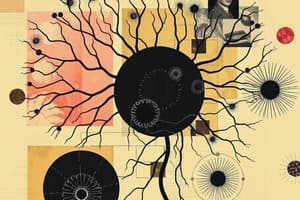Podcast
Questions and Answers
Which type of sensory receptors are primarily responsible for detecting changes in temperature?
Which type of sensory receptors are primarily responsible for detecting changes in temperature?
- Thermoreceptors (correct)
- Chemoreceptors
- Pain receptors
- Mechanoreceptors
What characterizes ionotropic receptors in sensory transduction?
What characterizes ionotropic receptors in sensory transduction?
- They activate G proteins.
- They are associated with slow signaling.
- They open ion channels as a direct response to a stimulus. (correct)
- They are involved in the detection of chemical stimuli.
Which part of the ear amplifies vibrations before they reach the cochlea?
Which part of the ear amplifies vibrations before they reach the cochlea?
- Oval window
- Outer ear
- Middle ear ossicles (correct)
- Tympanic membrane
What type of sensory receptors would respond to internal stimuli such as blood pH or osmotic pressure?
What type of sensory receptors would respond to internal stimuli such as blood pH or osmotic pressure?
Which classification describes receptors that are involved in the detection of external stimuli such as light and sound?
Which classification describes receptors that are involved in the detection of external stimuli such as light and sound?
What physical changes occur in the cochlea when pressure waves travel through its canals?
What physical changes occur in the cochlea when pressure waves travel through its canals?
How does the cochlea differentiate between different pitches of sound?
How does the cochlea differentiate between different pitches of sound?
What role do statoliths play in a plant's response to gravity?
What role do statoliths play in a plant's response to gravity?
What occurs in response to calcium accumulation on the upper side of a plant root during gravitropism?
What occurs in response to calcium accumulation on the upper side of a plant root during gravitropism?
What initiates the hearing process in the ear?
What initiates the hearing process in the ear?
Flashcards are hidden until you start studying
Study Notes
Classification of Sensory Receptors
- Sensory receptors are categorized based on energy transduced into five types: thermoreceptors, pain receptors, mechanoreceptors, chemoreceptors, and electromagnetic receptors.
- Receptors can be classified by sensory modality (type of stimulus), receptor mechanism (metabotropic or ionotropic), and location (exteroceptors or interoceptors).
Types of Sensory Receptors
- Metabotropic Receptors: Engage G proteins for a slower response upon stimulation.
- Ionotropic Receptors: Directly open ion channels, providing a fast response.
- Exteroceptors: Located externally and detect stimuli like sound and light.
- Interoceptors: Found internally, sensing changes such as pH and osmotic concentration.
Auditory System
- The vertebrate acoustico-lateralis system integrates hearing and equilibrium functions.
- Sound transmission begins in the exterior ear and involves the tympanic membrane and ossicles (malleus, incus, stapes).
- The stapes vibrates against the cochlea, generating pressure waves in cochlear fluid, leading to the activation of hair cells.
Organ of Corti
- Contains hair cells that respond to sound wave amplitude (volume) and frequency (pitch).
- Different regions of the basilar membrane are tuned to specific frequencies, allowing pitch discrimination.
Hearing Process
- Sound waves cause tympanic membrane vibrations, translated through ossicles to the cochlea.
- Pressure waves alter the basilar membrane, stimulating hair cells, which relay auditory information to the brain.
Gravity and Body Orientation
- The vestibular system consists of semicircular canals and otolith organs (saccule and utricle) to maintain balance and detect head position.
- Semicircular canals respond to angular head movements; otoliths help detect linear acceleration.
Visual System
- The vertebrate eye is structured with components for light entry (cornea), focusing (lens), and photoreception (retina).
- Rods are responsible for night vision, while cones facilitate color vision and high acuity.
- Phototransduction occurs when light converts retinal shapes, prompting signal transmission to the brain.
Color Vision in Humans
- Humans possess three types of cones sensitive to different wavelengths, facilitating color perception through contrasting signals.
- Color vision is determined by the ratios of red, green, and blue cones, allowing for wide spectrum recognition.
Plant Light Detection
- Plants utilize photoreceptors, such as phytochromes and cryptochromes, to monitor light presence, direction, intensity, and wavelength.
- Photoperiodism influences flowering based on light duration—short-day, long-day, and day-neutral plants follow distinct flowering cues.
Gravitropism in Plants
- Roots exhibit positive gravitropism while shoots show negative gravitropism through the settling of statoliths.
- The gravitational response influences auxin distribution in plants, regulating growth direction based on gravity's pull.
Studying That Suits You
Use AI to generate personalized quizzes and flashcards to suit your learning preferences.




